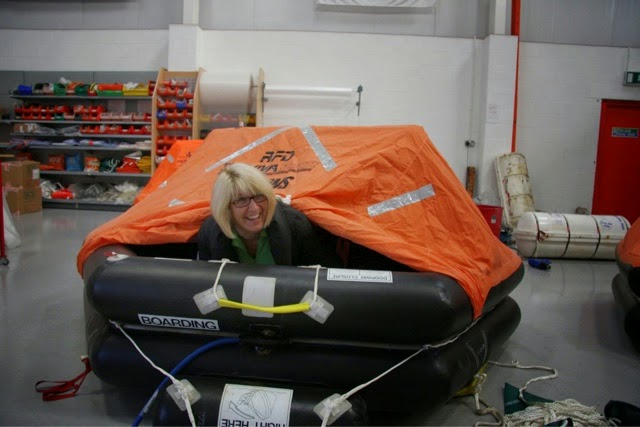(Emergency position indicating radio beacon). as these items are a/quite expensive and b/ have a limited life between services, normally three years or so it seemed sensible to wait until just before we depart on a long trip before purchasing.
After a bit of scouring on the internet and a few e-mails to local suppliers we were offered a chance to go to a local life raft service centre for a chat and the chance to actually see a few rafts unpacked, not something we ever hope to do in real life!
Luckily the day broke fine and after a quick phone call to establish a convenient time even more luckily we had a visit from Walter Scott of the Red Star Boat Club who kindly offered to run us to the location. The alternative would have been to walk quite a long way or take the dingy about 300 metres down the canal. Told you it was local...........
We were particularly taken by the difference between the commercial rafts,( RFD) and the usual Yottie rafts.
This particular one had been bought for £250 off Fleabay, and the owner was moaning because the service was going to cost another £300, moral don't buy rafts off E-Bay as you can probably buy a new one for not a lot more once its been properly serviced, of course that assumes there is NOTHING wrong with it, and we all know what assumptions are mothers of don't we? In actual fact this was a good one, however close examination revealed that the materials used in its construction were not in the same league as the commercial rafts and the canopy was unlined for example so it would have been a lot colder to sit in for any length of time. Its resistance to abrasion and punctures was also a bit of a lottery, Joe told us it would likely split were as the RFD would just hole and be readily repairable. Small things but worth a bit of thought now so we don't worry later.
We discussed the various equipment levels for ISAF ISO and SOLAS certification and Joe kindly showed us some of the stuff packed in a SOLAS A liferaft.
this includes pouches or sachets of fresh water, the large orange bag above is packed with about 5 litres per person, emergency food, the last time I tasted this on a course it was truly awful, this time however it was fairly palatable (tasted a bit like muesli bar) there are also repair kits, a CAT C first aid kit, pump paddles flares etc.
It certainly gave us a lot to think about, and thanks to Keith from KTS safety at Kilkeel, Paul and Joe at Newry, for giving us their time and the benefit of their experience. Also a big cheers to Walter for the lift, and the bottle of wine, a very nice man (from Fleetwood, so a fellow countryman)






No comments:
Post a Comment